Extremadura for Digital Nomads: Work and Lifestyle Tips
Living as a digital nomad in Extremadura is possible. Learn about accommodation, taxes and quality of life in this unique region of Spain.
Extremadura, a region in western Spain, is emerging as a key destination for those seeking new opportunities in the digital age. It’s famous for its vast landscapes of pastures, medieval castles and villages steeped in history.
Being a digital nomad in Extremadura is for you if you’re a remote professional who leads a quieter lifestyle and likes to live in places less saturated by mass tourism.
Stay with us to find out all the advantages and key facts about living and working in this part of Spain.
Why choose Extremadura to live as a digital nomad?
1. Low cost of living
One of the main reasons to be a digital nomad in Extremadura is its low cost of living compared to other more touristy regions of Spain. Affordable rents, delicious and inexpensive food, and a quieter life in general, make Extremadura an ideal place.
2. Internet connection and digitisation
The region has made significant progress in terms of digital infrastructure. In major cities such as Badajoz, Cáceres and Mérida, as well as in many smaller towns, high-speed internet access is common.
3. Natural environment and quality of life
The natural environment of Extremadura is breathtaking. From the Monfragüe National Park to the Jerte Valley region, there’s a wide variety of natural landscapes that invite you to disconnect and enjoy the outdoors.

The quality of life is high, with a more relaxed pace that allows you to balance work with time to enjoy recreational activities such as hiking, cycling, or cultural visits in a digital nomads community.
Extremadura is seeing a growing community of digital nomads, with more and more co-working spaces, local initiatives and networking events. Residents are known for their hospitality, which makes digital nomads feel welcome and supported in their daily lives.
5. Strategic location
Situated close to major cities such as Madrid and Lisbon, Extremadura is a perfect halfway point for those who wish to explore more of Spain and Portugal without living in the hustle and bustle of the big cities.
Visas allowing to be a digital nomad in Extremadura
Fortunately, Spain offers a digital nomad visa, designed for remote workers who wish to reside in the country.
The digital nomad visa is aimed at remote workers, freelancers and freelancers who wish to live in Spain and carry out their professional activity from there; it’s valid for an initial period of one year, with the possibility of renewal.
For more information on how to apply for this visa, please visit the full article on the digital nomad visa in Spain.
Where to live and work as a digital nomad in Extremadura?
Extremadura is emerging as a tempting destination for digital nomads, thanks to its low cost of living, calm, and good digital infrastructure. Here are the best cities and areas in the region to live and work remotely.
Badajoz: Urban life with access to nature
Badajoz, the capital of the province of the same name, is the largest city in Extremadura and offers a mix of urban life with the charm of a quieter region. It’s an excellent starting point for digital nomads looking for a fully serviced city with good connectivity, without the inconvenience of the hustle and bustle of big cities.
- Climate: Continental Mediterranean, with hot summers and mild winters.
- Atmosphere: Dynamic city with good co-working facilities and Wi-Fi in cafés.
- Advantages: Low cost of living, fast internet access, good connection to other nearby cities such as Lisbon.
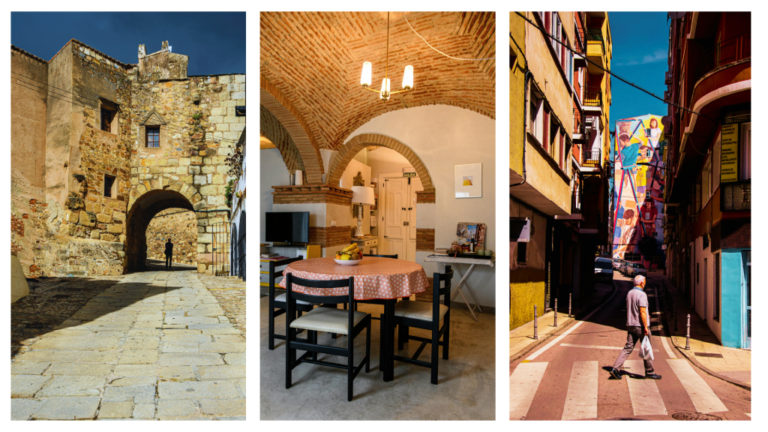
Cáceres: History and tranquillity
Cáceres, declared a World Heritage Site by UNESCO, is a city with a great historical and cultural wealth. It’s a perfect choice for digital nomads looking for a peaceful environment but with a strong connection to the past and to nature. In addition, Cáceres is investing in digitalisation, which makes it an increasingly attractive place for remote workers.
- Climate: Cold winters, very hot summers.
- Atmosphere: Quiet and picturesque town, great for those looking for concentration and a relaxed environment.
- Advantages: Affordable prices, growing digital connectivity, excellent quality of life.
Merida: Cultural heritage and nature
Mérida, famous for its impressive Roman ruins, is another one of the friendliest destinations for digital nomads in Extremadura. Its mix of history and nature, along with a milder climate, makes Mérida a perfect place to live and work remotely.
- Climate: Hot summers and mild winters.
- Environment: Cultural enjoyment.
- Advantages: Peace and quiet, emerging co-working spaces, excellent natural environment.
Rural areas: An escape from urban hustle and bustle
If you prefer a more rural setting away from the cities, Extremadura offers a wide variety of charming villages. Places like Trujillo, Jerez de los Caballeros and Plasencia are gaining popularity among digital nomads for their tranquillity, natural beauty and even lower cost of living.
- Climate: Similar to that of the cities, but with more natural freshness.
- Environment: For nomads who want to live in peace, surrounded by nature.
- Advantages: Low prices, less saturation, improving connectivity in many rural areas.
Accommodation in Extremadura
- Airbnb
It offers a variety of accommodation options, from shared rooms to full houses.
Approximate price:
- Shared room: From $25-40 per night.
- One-bedroom flat: From $ 50-80 per night.
- Full house: From $90-150 per night.
- Hotel Badajoz Center (Badajoz)
A modern hotel with a comfortable atmosphere and high-speed Wi-Fi throughout. It offers spacious rooms for those who need to work from their room.
- Estimated prices: From $60 to $150 per night depending on the season and the room.
- Home exchange
Platforms such as HomeExchange allow digital nomads to exchange homes with other travellers. This is a more flexible option for longer stays at a lower price.
- Pricing: The cost can be $0 if you have a home to exchange, or an annual subscription cost ranging from $100 to $200.
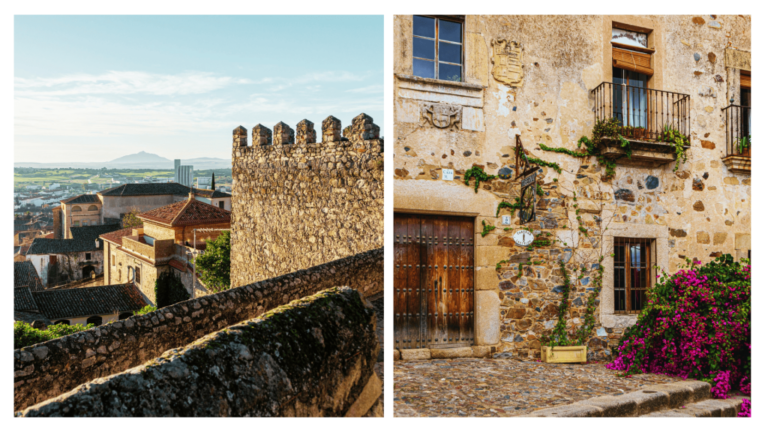
Co-working spaces in Extremadura
- Work Live (Badajoz)
- Services: Flexible desks, private offices, 24/7 access, fast internet, meeting rooms, events and activities.
- Prices:
- Shared desk: From $150 per month.
- Private office: From $300 per month.
- Daily access: From $20 per day.
- Klipforma Coworking (Cáceres)
- Services: Shared desks, private offices, fast internet, meeting room, 24/7 access, free coffee.
- Price:
- Shared desk: From $125 per month.
- Private office: From $300 per month.
- Daily access: From $15 per day.
Internet connection in Extremadura
Internet connectivity in Extremadura has improved considerably in recent years, especially in major cities such as Badajoz, Cáceres and Mérida. In general, the region has access to fibre optics in urban areas, ensuring a fast and stable connection for remote work.
In major cities, the average download speed is 100-300 Mbps (fibre optic). In rural areas, speeds may be slower, but 4G and 5G connections are available in many places.
Public spaces with good internet connection
1. Badajoz public library: A quiet space with free high-speed Wi-Fi, ideal for working in a serene environment.
2. Parks and green areas: In cities such as Mérida and Cáceres, parks and green areas such as the Parque de las VII Sillas in Mérida or the Parque de los Cañones in Cáceres are popular spaces to work outdoors with Wi-Fi connection.
If you prefer to work from anywhere in Spain without worrying about the connection, we recommend you use Holafly’s Spain eSIM with unlimited data. Connect quickly and easily from anywhere in Spain!
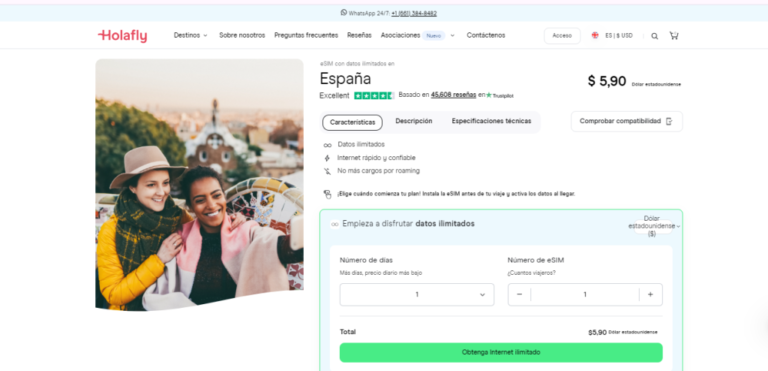
How does a digital nomad in Extremadura pay taxes?
As a digital nomad in Extremadura, you will be subject to the tax laws of Spain, which includes paying taxes on your income generated within the country. Here’s what you need to know:
- Tax residency: If you spend more than 183 days a year in Spain, you’ll be considered a tax resident in the country, and you’ll be taxed on your overall income. This means that, even if you work for companies outside Spain, you’ll have to declare your income to the Spanish Tax Agency.
- Tax rate: Digital nomads are subject to the Spanish tax system, which includes personal income tax (IRPF). Rates vary depending on income level, with a progressive rate ranging from 19% to 47% on the highest incomes.
Spain has double taxation treaties with several countries, allowing digital nomads to avoid paying tax twice on the same income (in their home country and in Spain). Some of the countries with which Spain has these agreements are:
- United States
- United Kingdom
- Germany
- France
- Mexico
- Argentina
Important: If you are a frequent traveler and want to stay connected without worrying about expensive roaming or looking for a new SIM at every destination, Holafly’s subscription plans are for you. With a single eSIM, enjoy internet in more than 170 countries for a fixed price and no surprises on your bill. Travel without limits and connect easily and securely! 🚀🌍

Health insurance and quality of health service in Extremadura
The health system in Extremadura is part of Spain’s National Health System (SNS) , which provides access to high quality public health care for residents. Access to this service is free or low-cost, and covers primary care, medical consultations, hospitalisation, and medical treatment.
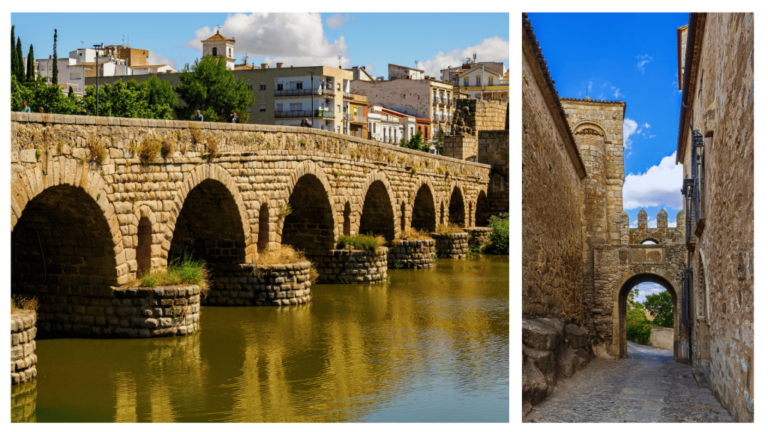
Quality of medical care
The quality of care is high in both the public and private sectors, and medical practices are well equipped to cater to digital nomads.
Although residents in Spain can access the public health system, many digital nomads prefer to have private health insurance to ensure shorter waiting times and greater flexibility.
Some recommended health insurances are:
| Sanitas | Flexible medical plans for expatriates and digital nomads, with access to a wide network of hospitals and clinics. Prices range from $50 and $100 per month. |
| Adeslas | Another popular private insurance, with comprehensive coverage including national and international medical care. Prices are similar, from $50 to $120 per month. |
| Mediquall | This insurance is ideal for digital nomads who want fast health services and coverage throughout Spain. Prices average $40-90 per month. |
Basic expenses of a digital nomad in Extremadura
Transport and Mobility in Extremadura
Driving in Extremadura
- Foreign licence: If you’re resident in Spain, you can use your foreign driving licence for a maximum period of 6 months. After this deadline, you must exchange your foreign licence for a Spanish licence if you’re a resident. Some countries have agreements with Spain for the direct validation of licences, such as the United Kingdom and several EU countries.
- Validation: If your country doesn’t have an agreement with Spain, you’ll have to take a driving test to obtain a Spanish licence.
Public transport options
- Trains: Renfe operates in Extremadura, with routes between cities such as Badajoz, Cáceres and Mérida. Prices average between $15 and $30 per journey, depending on distance and type of train.
- Buses: The main cities of Extremadura are connected by an efficient intercity bus system. Prices for short journeys are around $5to $15.
- Taxis: Taxis in Extremadura have standard fares of less than $2 per kilometre, and a base fare of almost three dollars.
- Shared vehicles: Applications such as BlaBlaCar allow carpooling between cities at prices ranging from $5 to $20, depending on the distance.
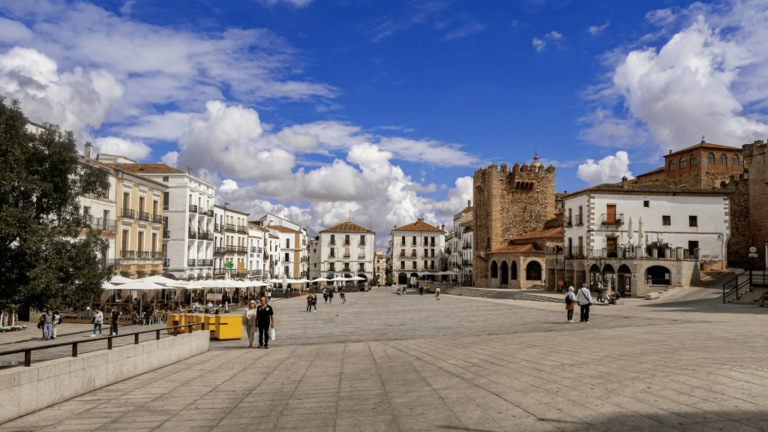
Managing finances of a digital nomad in Extremadura
Recommended banks for foreigners
- Banco Santander: Offers accounts for non-Spanish residents. The monthly fee for maintaining a basic account is usually $5, but there are free options if you meet certain income or balance requirements.
- BBVA: Also very accessible to foreigners. They offer accounts without maintenance fees if you make a regular monthly deposit.
- Digital banks:
- N26: A 100% digital bank, ideal for nomads, that doesn’t charge maintenance fees or fees for international transfers within the Eurozone.
- Revolut: Another excellent digital option that allows international transactions with low fees and the ability to hold multiple currencies in the same account.
Cash withdrawals and ATMs
ATMs are available in all major towns in Extremadura. Withdrawal fees at third-party ATMs can range from $3 to $5 per transaction.
N26 and Revolut charge low or even zero fees for international transactions within the Euro area. For withdrawals at ATMs outside the Euro area, both options allow a number of free withdrawals per month.
Food costs in Extremadura
Supermarkets and shopping
The most common supermarkets in Extremadura are Mercadona, Carrefour and Dia. In these, the average monthly cost of food for one person can be $200 to $350, depending on the type of diet and the brands chosen.
Cost of meals in markets and restaurants
- Menu of the day: From $10 to $15; fast and full meals.
- Dinner in a restaurant: $20 to $30 for a full meal.
- In more touristy or specialised restaurants, prices can go up to $40-60 per person.
- In markets such as those in Badajoz or Cáceres, fresh produce (fruit, vegetables, meat and fish) is usually cheaper than in conventional supermarkets. Here, the monthly food budget could drop to around $150-250 if you buy local and seasonal produce.
Entertainment for digital nomads in Extremadura
The cost of outdoor activities and sightseeing can be low or free, while festivals and events can have ticket prices from $10 to $50, depending on the show.
Cultural and tourist activities
- Extremadura is known for its historical heritage and medieval villages. You can’t miss the Monumental City of Cáceres (World Heritage Site), the roman ruins of Mérida or the Castle of Badajoz.
- Festivals: Extremadura is host to several music and art festivals, such as the International Festival of Classical Theatre of Mérida which is held in summer. Other popular events are the Festivities of San Juan in Badajoz and the summer fairs in several towns.
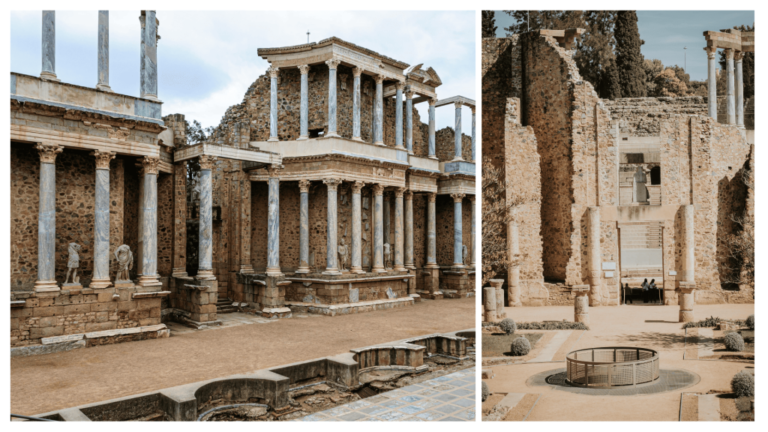
Sports and nature
- Extremadura is ideal for outdoor sportsenthusiasts, with activities such as hiking in the Natural Parks of Monfragüe and La Vera or water sports in the reservoirs of Cijara and Gabriel y Galán.
Best seasons to be in Extremadura
Spring (March to June) and Autumn (September to November) are the best times to enjoy the mild climate in Extremadura and work outdoors. Temperatures are between 15 and 25ºC.
Summer (June to September) can be very hot, especially in the south of the region, with temperatures over 35ºC. If you settle during this time, be sure to pack light clothing, sunscreen and adapt to the heat.
Winter (December to February) can be cold, especially in rural and mountainous areas, with temperatures below freezing. Be prepared with warm clothes if you visit during this time.
Cost of living as a digital nomad in Extremadura
All in all, we can say that the average monthly cost of living for a digital nomad in Extremadura can range from $1,000 to $2,000, depending on your accommodation, transport and lifestyle choices. This makes Extremadura a fairly affordable option for those seeking a balanced quality of life and a relaxed environment in which to work remotely.
Frequenty Asked Questions about being a digital nomad in Extremadura
Yes, it offers a low cost of living, good internet connection and a quiet environment ideal for working remotely.
The average monthly cost of living is between $1,000 and $2,000, depending on accommodation, transport and lifestyle.
You can find accommodation on Airbnb, hotels like Badajoz Center or even exchange houses through platforms like HomeExchange.
Yes, places like Work Live in Badajoz and Klipforma Coworking in Cáceres offer shared workspaces from $125-150 per month.
If you’re a tax resident (more than 183 days in Spain), you will be taxed on your global income at rates between 19% and 47%, and can benefit from double taxation treaties with countries such as the US, UK and Mexico.
Insurances such as Sanitas or Adeslas offer private medical coverage from $50 to $120 per month, as well as access to the public health network.





 Language
Language 


















 No results found
No results found


